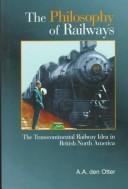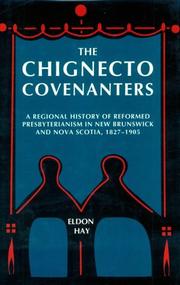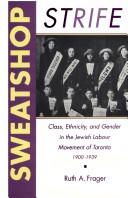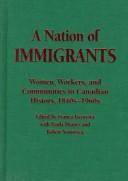| Listing 1 - 10 of 13 | << page >> |
Sort by
|
Digital
Year: 1838 Publisher: London W.S. Orr, P. Richardson, and J. Ridgway
Abstract | Keywords | Export | Availability | Bookmark
 Loading...
Loading...Choose an application
- Reference Manager
- EndNote
- RefWorks (Direct export to RefWorks)
Bank of British North America --- Colonial Bank --- Currency question -- Canada --- Banks and banking -- Canada

ISBN: 1282025589 9786612025587 1442678461 9781442678460 0802041612 9780802041616 Year: 1997 Publisher: Toronto
Abstract | Keywords | Export | Availability | Bookmark
 Loading...
Loading...Choose an application
- Reference Manager
- EndNote
- RefWorks (Direct export to RefWorks)
"When, in the late 1980s, the federal government initiated a plan to deregulate the Canadian railway system, lobby groups protested the betrayal of a national mandate. They asserted that the railway was founded to promote a sense of national identity, to provide access to isolated regions of the country, and to ensure a transnational exchange of goods and ideas. In The Philosophy of Railways, A.A. den Otter considers the relationship between nationalism and technology, and shows how the popular rhetoric surrounding the evolution of the Canadian Pacific Railway has mythologized the role of a private corporation and its technology. He questions the notion that the railways were built as an antidote to American manifest destiny, suggesting instead that the widespread adoption of railway transportation as a civilizing mission impelled Canadians to bow to technology's integrating effects, including confederation and closer ties with the United States."--Jacket.
Railroads --- History. --- Canadian Pacific Railway Company --- Canadian Pacific Railway (Firm) --- Canadian Pacific (Firm : 1881-1971) --- CP Rail --- Canadian Pacific Limited --- Britisch-Nordamerika --- Canada. --- Canada (Province) --- Canadae --- Ceanada --- Chanada --- Chanadey --- Dominio del Canadá --- Dominion of Canada --- Jianada --- Kʻaenada --- Kaineḍā --- Kanada --- Ḳanadah --- Kanadaja --- Kanadas --- Ḳanade --- Kanado --- Kanakā --- Province of Canada --- Republica de Canadá --- Yn Chanadey --- Großbritannien --- Nordamerika --- British North America --- Kolonie --- Englische Kolonie
Book
ISBN: 1442660740 9781442660748 9781442644519 1442644516 1442660759 Year: 2015 Publisher: Toronto
Abstract | Keywords | Export | Availability | Bookmark
 Loading...
Loading...Choose an application
- Reference Manager
- EndNote
- RefWorks (Direct export to RefWorks)
Alan Wilson brings MacGregor and his surroundings to life, detailing his numerous achievements and establishing his importance to the social, religious, and intellectual history of the Maritimes.
Presbyterians --- Scottish Canadians --- Protestants --- Calvinistic Methodists --- MacGregor, James, --- McGregor, James, --- M'Gregor, James, --- MacGriogair, Seumas, --- Presbyterian Church of Nova Scotia --- History. --- Clergy --- Nova Scotia --- Nouvelle-Ecosse --- Free Church of Nova Scotia --- Presbyterian Church of the Lower Provinces of British North America
Book
ISBN: 022628073X 9780226280738 9780226280561 022628056X Year: 2015 Publisher: Chicago London
Abstract | Keywords | Export | Availability | Bookmark
 Loading...
Loading...Choose an application
- Reference Manager
- EndNote
- RefWorks (Direct export to RefWorks)
The history of slavery in early America is a history of suicide. On ships crossing the Atlantic, enslaved men and women refused to eat or leaped into the ocean. They strangled or hanged themselves. They tore open their own throats. In America, they jumped into rivers or out of windows, or even ran into burning buildings. Faced with the reality of enslavement, countless Africans chose death instead. In The Power to Die, Terri L. Snyder excavates the history of slave suicide, returning it to its central place in early American history. How did people-traders, plantation owners, and, most importantly, enslaved men and women themselves-view and understand these deaths, and how did they affect understandings of the institution of slavery then and now? Snyder draws on ships' logs, surgeons' journals, judicial and legislative records, newspaper accounts, abolitionist propaganda and slave narratives, and many other sources to build a grim picture of slavery's toll and detail the ways in which suicide exposed the contradictions of slavery, serving as a powerful indictment that resonated throughout the Anglo-Atlantic world and continues to speak to historians today.
Enslaved persons --- Slavery --- Suicide --- Suicidal behavior --- History. --- slaves, slavers, enslaved people, slavery, suicide, death, end of life, mental health, british, north america, american, united states, usa, history, historical, academic, scholarly, research, colonialism, colonial, colonist, race, racism, racist, atlantic, ships, rebellion, trader, plantation owner, plantations, institutions, tragedy, abolitionist, abolition.
Book
ISBN: 0228015200 Year: 2022 Publisher: Montreal ; Kingston ; London ; Chicago : McGill-Queen's University Press,
Abstract | Keywords | Export | Availability | Bookmark
 Loading...
Loading...Choose an application
- Reference Manager
- EndNote
- RefWorks (Direct export to RefWorks)
The Enlightenment Atlantic was awash in deep feelings. People expressed the ardour of patriots, the homesickness of migrants, the fear of slave revolts, the ecstasy of revivals, the anger of mobs, the grief of wartime, the disorientation of refugees, and the joys of victory. Yet passions and affections were not merely private responses to the events of the period – emotions were also central to the era’s most consequential public events, and even defined them. In Enthusiasms and Loyalties Keith Grant shows that British North Americans participated in a transatlantic swirl of debates over emotions as they attempted to cultivate and make sense of their own feelings in turbulent times. Examining the emotional communities that overlapped in Cornwallis Township, Nova Scotia, between 1770 and 1850, Grant explores the diversity of public feelings, from disaffected loyalists to passionate patriots and ecstatic revivalists. He shows how certain emotions – especially enthusiasm and loyalty – could be embraced or weaponized by political and religious factions, and how their use and meaning changed over time. Feelings could be the glue that made loyalties stick, or a solvent that weakened community bonds. Taking a history of emotions approach, Enthusiasms and Loyalties aims to recover and understand the wide range of political and religious emotions that were possible – feelable – in the Enlightenment Atlantic.
Emotions --- Political aspects --- History --- Religious aspects --- Social aspects --- American. --- Annapolis Valley. --- BNA. --- British North America. --- Canada. --- Christianity. --- Edward Manning. --- Handley Chipman. --- Henry Alline. --- Jacob Bailey. --- Maritimes. --- New England. --- New Light. --- Nova Scotia. --- Protestantism. --- affections. --- book history. --- community. --- devotion. --- emotional communities. --- evangelical. --- evangelicalism. --- great awakening. --- history of emotions. --- identity. --- loyalism. --- loyalist. --- piety. --- planters. --- print culture. --- reading. --- revival. --- revolutions. --- sensibility. --- sentiment. --- sympathy.

ISBN: 1282854119 9786612854118 0773566201 9780773566200 0773514368 9780773514362 Year: 1996 Publisher: Montreal, Que. McGill-Queen's University Press
Abstract | Keywords | Export | Availability | Bookmark
 Loading...
Loading...Choose an application
- Reference Manager
- EndNote
- RefWorks (Direct export to RefWorks)
Drawing on unpublished stories, minutes, and reminiscences of Chignecto clergymen, Hay delineates Covenanter life, exploring its beliefs and traditions, leadership, relations with other Presbyterian bodies, and the causes of the movement's collapse. He focuses on two key figures in the movement, Reverend Alexander Clarke, an Irish missionary who established Reformed Presbyterian congregations in the area, and Reverend Joseph Howe Brownell, who consolidated the congregations and led them into the Presbyterian Church of Canada in 1905. The Chignecto Covenanters fills an important gap in the history of Canadian Presbyterianism and of the Maritime region. "A model of how micro-history can be portrayed within a macro-context, The Chignecto Covenanters fills a gap in Maritime regional history and makes a significant contribution to the broader fields of Canadian religious and cultural history." John Moir, Emeritus Professor of History, University of Toronto.
Presbyterian Church --- Christian sects --- History. --- New Brunswick --- Nova Scotia --- Nouveau-Brunswick --- Church history. --- Clarke, Alexander, --- Brownell, Joseph Howe, --- Presbyterian Church in Canada --- Eglise presbytérienne au Canada --- Eglise presbytérienne du Canada --- Presbyterian Church of the Lower Provinces of British North America --- Presbyterian Church of Canada in Connection with the Church of Scotland --- Canada Presbyterian Church --- Presbyterianism. --- Reformed Presbyterian Church of North America --- Reformed Presbyterian Church in North America, General Synod. --- Church history
Book
ISBN: 9780228013464 0228013461 Year: 2022 Publisher: Montreal Kingston London Chicago
Abstract | Keywords | Export | Availability | Bookmark
 Loading...
Loading...Choose an application
- Reference Manager
- EndNote
- RefWorks (Direct export to RefWorks)
This collection employs biography, botanical data, herbaria specimens, archival sources, letters, institutional records, book history, and artwork to reconstruct plant work by figures ranging from elite women involved in imperial botanical projects in British North America to settler-colonial women in mid- and late-century Ontario and Australia.
Botanists --- Botany --- Women botanists. --- History --- Australia. --- British North America. --- Catharine Parr Traill. --- Empire. --- Indigenous. --- Lady Dalhousie. --- Ontario. --- Settler. --- Victorian. --- absences. --- amateur. --- archives. --- art. --- biography. --- botanical history. --- botanist. --- botany. --- class. --- collecting. --- colonial. --- culture. --- drawing. --- education. --- ethnicity. --- family. --- female agency. --- feminist. --- floras. --- flowers. --- gardens. --- gender. --- herbaria. --- historiography. --- home. --- horticulture. --- illustration. --- letters. --- masculinity. --- native. --- natural history. --- nature. --- networks. --- plants. --- popular practices. --- pre-Confederation. --- print culture. --- professional. --- recovery. --- schooling. --- science. --- scientific. --- silences. --- societies. --- studies. --- teaching. --- trans-atlantic. --- ways knowing. --- women.

ISBN: 1282056581 9786612056581 1442680318 9781442680319 0802059686 0802068952 9780802068958 9780802059680 1442615133 Year: 1992 Publisher: Toronto
Abstract | Keywords | Export | Availability | Bookmark
 Loading...
Loading...Choose an application
- Reference Manager
- EndNote
- RefWorks (Direct export to RefWorks)
In the first half of the twentieth century, many of Toronto's immigrant Jews eked out a living in the needle-trade sweatshops of Spadina Avenue. In response to their expliotation on the shop floor, immigrant Jewish garment workers built one of the most advanced sections of the Canadian and American labour movements. Much more than a collective bargaining agency, Toronto's Jewish labour movement had a distinctly socialist orientation and grew out of a vibrant Jewish working-class culture.Ruth Frager examines the development of this unique movement, its sources of strength, and its limitations, focusing particularly on the complex interplay of class, ethnic, and gender interests and identities in the history of the movement. She examines the relationships between Jewish workers and Jewish manufacturers as well as relations between Jewish and non-Jewish workers and male and female workers in the city's clothing industry.In its prime, Toronto's Jewish labour movement struggled not only to improve hard sweatshop condistions but also to bring about a fundamental socialist transformation. It was an uphill battle. Drastic economic downturns, hard employer offensives, and state repressions all worked against unionists' workplace demands. Ethnic, gender, and ideological divisions weakened the movement and were manipulated by employers and their allies.Drawing on her knowledge of Yiddish, Frager has been able to gain access to original records that shed new light on an important chapter in Canadian ethnic, labour, and women's history.
Jewish labor unions --- Labor movement --- Women in the labor movement --- Jews --- History. --- Jewish trade-unions --- Hebrews --- Israelites --- Jewish people --- Jewry --- Judaic people --- Judaists --- Labor and laboring classes --- Labor unions --- Ethnology --- Religious adherents --- Semites --- Judaism --- Social movements --- Trade-unions --- Clothing workers --- Industrial unions --- Labor, Organized --- Labor organizations --- Organized labor --- Unions, Labor --- Unions, Trade --- Working-men's associations --- Societies --- Central labor councils --- Guilds --- Syndicalism --- History --- E-books --- Juden. --- Canada --- Toronto --- Ontario --- Relations interethniques. --- York --- Metropolitan Toronto --- Amérique du Nord britannique --- British North America --- Canada (Dominion) --- Canada (Province) --- Canada-Uni --- Nouvelle-France --- Région frontalière canado-américaine --- Amérique du Nord --- Frontières --- Provinces anglophones

ISBN: 1442687274 9781442687271 9781487516833 1487516835 0802004660 0802074820 9780802074829 9780802004666 9781487516680 1487516681 1442690666 Year: 1998 Publisher: Toronto
Abstract | Keywords | Export | Availability | Bookmark
 Loading...
Loading...Choose an application
- Reference Manager
- EndNote
- RefWorks (Direct export to RefWorks)
This collection brings together a wide array of writings on Canadian immigrant history, including many highly regarded, influential essays. Though most of the chapters have been previously published, the editors have also commissioned original contributions on understudied topics in the field. The readings highlight the social history of immigrants, their pre-migration traditions as well as migration strategies and Canadian experiences, their work and family worlds, and their political, cultural, and community lives. They explore the public display of ethno-religious rituals, race riots, and union protests; the quasi-private worlds of all-male boarding-houses and of female domestics toiling in isolated workplaces; and the intrusive power that government and even well-intentioned social reformers have wielded over immigrants deemed dangerous or otherwise in need of supervision.Organized partly chronologically and largely by theme, the topical sections will offer students a glimpse into Canada's complex immigrant past. In order to facilitate classroom discussion, each section contains an introduction that contextualizes the readings and raises some questions for debate. A Nation of Immigrants will be useful both in specialized courses in Canadian immigration history and in courses on broader themes in Canadian history.
Immigrants --- Minoritie --- Working class --- Women --- Commons (Social order) --- Labor and laboring classes --- Laboring class --- Labouring class --- Working classes --- Social classes --- Labor --- History. --- Employment --- Canada --- Ethnic relations. --- Race relations. --- Social life and customs. --- Kanada --- Canada. --- Relations interethniques. --- Emigration and immigration. --- Minorities. --- Moeurs et coutumes. --- Canada (Province) --- Canadae --- Ceanada --- Chanada --- Chanadey --- Dominio del Canadá --- Dominion of Canada --- Jianada --- Kʻaenada --- Kaineḍā --- Ḳanadah --- Kanadaja --- Kanadas --- Ḳanade --- Kanado --- Kanakā --- Province of Canada --- Republica de Canadá --- Yn Chanadey --- Puissance du Canada --- Kanadier --- Provinz Kanada --- 01.07.1867 --- -Amérique du Nord britannique --- British North America --- Canada (Dominion) --- Canada-Uni --- Nouvelle-France --- Région frontalière canado-américaine --- Amérique du Nord --- Frontières --- Provinces anglophones
Book
ISBN: 0809334178 9780809334179 9780809334162 080933416X Year: 2015 Publisher: Carbondale, [Illinois]
Abstract | Keywords | Export | Availability | Bookmark
 Loading...
Loading...Choose an application
- Reference Manager
- EndNote
- RefWorks (Direct export to RefWorks)
Emigration and immigration --- Canadian Americans --- Protestant converts --- Catholic ex-priests --- Ex-Catholic priests --- Ex-priests, Catholic --- Former Catholic priests --- Ex-clergy --- Converts, Protestant --- Christian converts --- Protestants --- Canadians --- Ethnology --- Immigration --- International migration --- Migration, International --- Population geography --- Assimilation (Sociology) --- Colonization --- Social aspects --- History --- Illinois --- Chiniquy, Charles Paschal Telesphore, --- Chiniquy, Charles, --- Khinikvi, --- Shiniki, --- Presbyterian Church in Canada --- Eglise presbytérienne au Canada --- Eglise presbytérienne du Canada --- Clergy --- Presbyterian Church of the Lower Provinces of British North America --- Presbyterian Church of Canada in Connection with the Church of Scotland --- Canada Presbyterian Church
| Listing 1 - 10 of 13 | << page >> |
Sort by
|

 Search
Search Feedback
Feedback About UniCat
About UniCat  Help
Help News
News